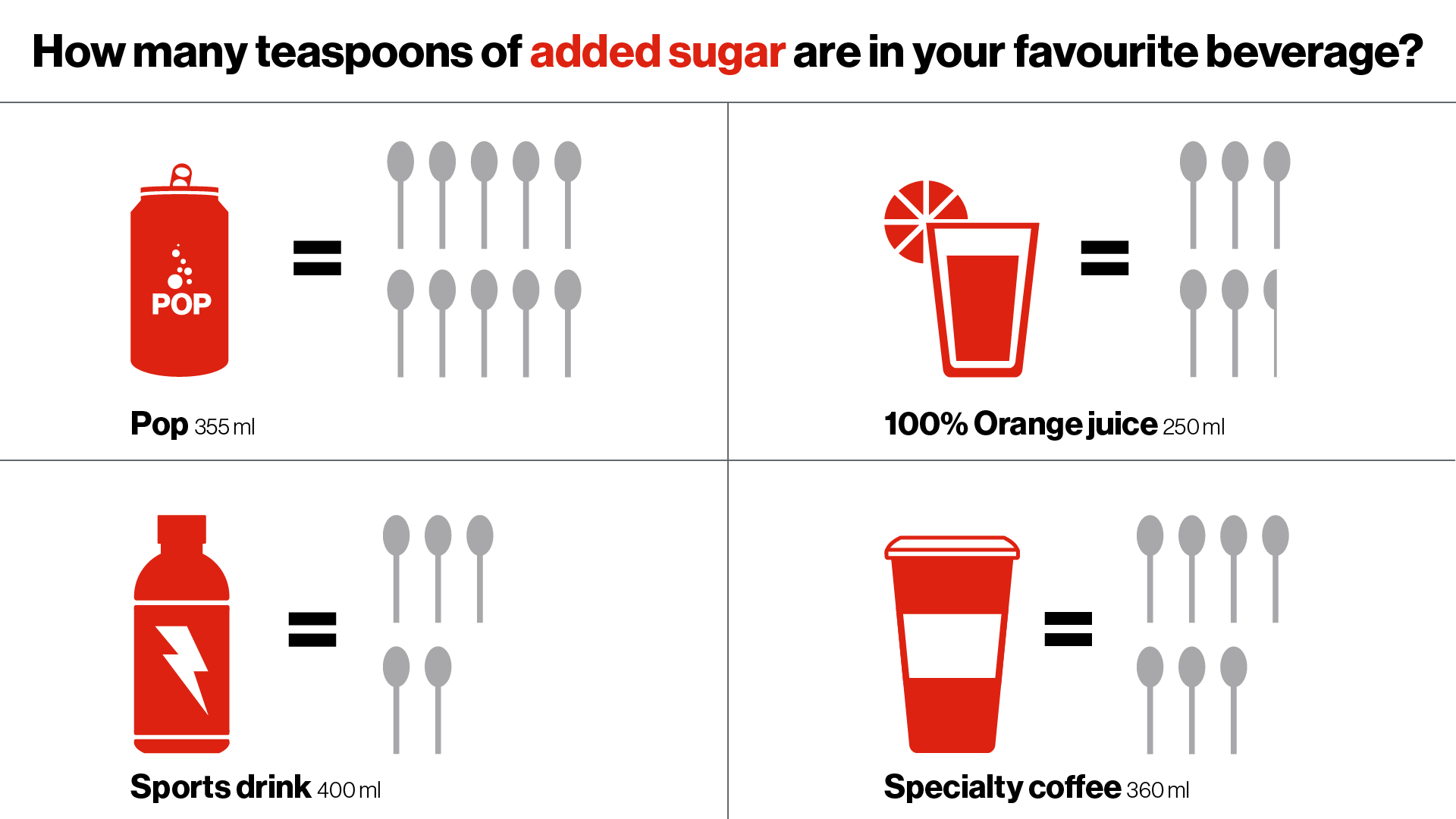What is sugar?
Sugar is found in many foods, both naturally or added. Sugar provides energy (calories) but has no nutritional value on its own. Sugars are often added to processed foods to improve their flavour, colour, texture and shelf-life.
Sugar comes in many forms: white sugar, brown sugar, molasses, honey, maple syrup and corn sweeteners. It may be listed on the ingredient listing on food labels as:
- glucose
- fructose
- dextrose
- maltose
- sucrose.
All of the different types of sugars are grouped together in the ingredient list to make it easier to see just how much sugar is in a food. If sugars are listed as the first or second ingredient on a food label, the food is likely high in sugar.
Some foods that naturally contain sugar, such as vegetables, fruit and milk, are an important part of a healthy diet, because they also contain important nutrients. All other sugars are called ‘free sugars’. Free sugars are sugars added to food products, and sugar naturally present in honey, syrups, fruit juices and purées. Free sugars provide little or no nutritional value.
How does sugar affect our health?
Consuming too much sugar is associated with heart disease, stroke, obesity, diabetes, high blood cholesterol, cancer and cavities.
How much sugar should we eat?
Heart & Stroke recommends you consume no more than 10% total calories per day from added sugars, and ideally less than 5%; that is, for an average 2,000 calorie-a-day diet, 10% is about 48 grams (or 12 teaspoons) of added sugars. One can of pop contains about 85% (or approx. 10 teaspoons) of daily added sugar.
Foods that naturally contain sugar such as vegetables, fruit and milk should be included in a healthy diet in reasonable quantities.
Foods that are high in free sugar include:
- Sweetened cold and hot beverages, such as soft drinks, energy drinks, fruit flavoured drinks, fruit juices, sports drinks, hot chocolate and specialty coffees.
- Baked goods and desserts such as cakes, candies, chocolate, cookies, doughnuts, ice cream, muffins, pastries and pies.
Are you drinking too much sugar?
Many popular drinks have more than half of your recommended daily sugar intake.

For an average 2000 calorie a day diet, 10% is about 12 teaspoons.
Tips to reduce your sugar intake
1. Don’t drink your calories.
Avoid sugary drinks. Drink water instead, when you are thirsty. Low-fat, unsweetened milk is also a good way to quench thirst.
- To keep things interesting, flavour your water with lemon, orange or lime slices, strawberries or fresh mint.
- Avoid soft drinks and sports drinks. They are high in sugar and have no nutritional value (which is why they are called “empty calories”).
- Avoid fruit juice, even when it is 100% fruit juice. Although fruit juice has some of the benefits of the fruit (vitamins, minerals), it has more sugar than the fruit and less fibre. Fruit juice should not be consumed as alternative to fruits. Canadians should eat their fruits, not drink them.
- Stay away from fancy hot drinks with free sugars. Order a latte instead of a mocha coffee. Add nutmeg and cinnamon toppings for extra flavor rather than adding sugar.
2. Try whole foods. Whole foods are items that remain close to their natural state as possible with little processing. Examples are: fresh or frozen vegetables and fruit, poultry and fish, beans, lentils or tofu, brown rice, whole wheat couscous, barley, whole grain breads, plain lower-fat milk, plain yogurt and cheeses.
3. Snack sensibly. Stock up on roasted nuts, lower-fat, lower-sodium cheese and crackers, veggies and dip, and plain yogurt with fresh fruit. Reduce the amount of baked goods, sweet desserts, candies, and chocolates you eat.
4. Eat lower-sugar cereals. Choose cereals with less than 6 grams of sugar and more than 4 grams of fibre per 1 cup (30 gram) serving.
5. Cook at home more often. Select recipes that are lower in sugar. Check out our recipe section for a wide variety of delicious recipes. Also, you can experiment with your favourite recipes by reducing the amount of added sugar to your recipes by one-quarter to one-third.
6. Read the Nutrition Facts table and the ingredient list on packaged foods. Pay special attention to the serving size, total amount of sugar and read the ingredient list. The Nutrition Facts table will tell you the total amount of sugar in the product (from both naturally occurring and added sugars) and the ingredient list will let you know where the sugar is coming from.
Products with added sugars such as glucose, fructose, sucrose, honey, evaporated cane juice, fruit puree, molasses, corn syrup, dextrose, concentrated fruit juice provide no nutritional benefits – minimize or remove these items from your shopping list.
Related Information
Find healthy, reduced-sugar recipes.
Try these tips for getting more healthy produce into your diet.
